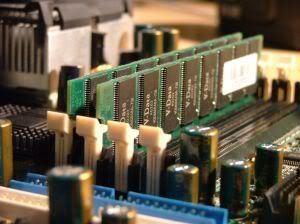We have discussed about the selection of computer main memory. We shall do a bit more information sharing on the main memory in this series. We start off with accquainting ourselves with the computer main memory terminologies:
What are SIMMs and DIMMs? The computer motherboard comes with a RAM form factor. Basically, the size and type of the slot available corresponds to the compatibility of the motherboard with the type of memory module.
The Single-In-Line Memory Module (SIMM) has 72 pins (earlier version had 30 pins). Pins refer to the contact points on the slotted end of the module, which fit into the computer motherboard. It has a redundant set of pins on both sides of the module.
The Dual-In-Line memory module (168 pin) is the predominant main memory available in the market today, because of its higher data transfer capacity because of a 64-bit path rather than a 32-bit path as offered by the SIMM modules. The main difference is that while the SIMM pins have electrical contacts on both sides that are connected, the pins on a DIMM have isolated electrical contacts which provide higher data rate.
The predominant DIMMs available in the market today are the SDRAM and the DDR SDRAM (types of DRAM).
What is DRAM? Dynamic Random Access Memory. The word Dynamic denotes the fact that the RAM is able to store data only if accessed constantly by the refresh circuit.
SDR(Synchronous Data Rate) RAM has the ability to synchronize itself with the timing of the CPU. DDR(Double Data Rate) RAM on the other hand, has double the rate of SDR, for e.g. if the SDR has FSB of 100MHz or 133 MHz, the DDR will have 200MHz or 266MHz speed respectively.
One of the most popular questions about the SDR and DDR memory modules is that, “Can we use both at the same time?” – The answer is NO. We can use only one type at a time but not both.
Apart from that, we have the DDR2 memory wherein the memory modules run at faster speeds (400 – 1000MHz range), however, higher latency causes it to run at a lower speed than DDR. To have similar/higher performance than DDR, look for DDR2 800MHz or higher.
What is the FSB (Front Side Bus) speed that we have been talking about? It is the speed at which the microprocessor communicates with the main memory and it is a function of the motherboard. We shall talk about the classifications of memory and the implications of FSB in the subsequent part of this article.
Friday, August 17, 2007
Computer Main Memory - Part I
Subscribe to:
Post Comments (Atom)


1 comment:
Useful read describing the functionality of computers Main Memory. Thanks for sharing updated information with us
Post a Comment